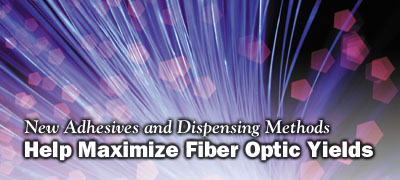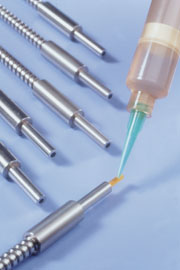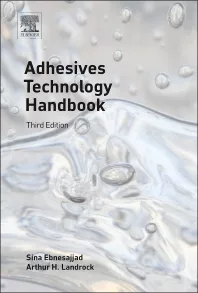New Adhesives and Dispensing Methods Help Maximize Fiber Optic Yields

Manual application of thermally cured epoxy adhesives with medical syringes, dental picks and similar tools has long been the norm in fiber optic assembly. However, the need to produce high-quality devices more efficiently is forcing companies to re-evaluate their current assembly processes and search for more productive alternatives.
Thermally cured epoxies have been in use for many years. They offer reliable performance and are found in applications that range from bonding fibers to ferrules to backfilling connectors and collimators.
While thermal-cure epoxies are still widely used throughout the fiber optic industry, UV-cure adhesives that cure quickly when exposed to an ultraviolet light source are being incorporated into a growing number of processes. UV-cures have evolved to the point where today's formulations are emerging as the preferred bonding agents for many applications. The methods by which these epoxies, UV-cures and other assembly fluids are applied are also getting a closer look.
Interest in UV-cure adhesives has been steadily increasing because today's formulations offer performance on a par with thermal-cure adhesives, but with significantly shorter process times -- there are UV systems that can be cured in just a few seconds (see table). And since UV-cure adhesives are typically single-component materials, they can save time and effort by eliminating the need for time-consuming mixing and outgassing operations.
How UV-Cure Adhesives Have Evolved
Characteristics of today's UV- and visible light-curing adhesives include low moisture absorption to assure reliable performance in high-temperature/high-humidity environments, a low coefficient of thermal expansion or CTE (particularly in filled grades) to reduce stress and damage, low shrinkage to maintain critical alignment during curing and field use, and low outgassing to prevent contamination inside sealed or hermetic packages.
Adhesive Dispensers Can Improve Yields and Process Control
Few assembly applications are as demanding as fiber optics, where extremely tight physical and optical tolerances make the size and placement of adhesive deposits critical to performance and productivity. Yet, while many of today's devices incorporate the latest technology, assembling them can be a frustratingly labor-intensive process in which quality and output are often overly dependent on the skill and experience of the individual operator.In many production environments, operators still apply epoxies and adhesives with medical syringes or other manual applicators. Because the amount of material applied depends upon how hard the syringe's plunger is pressed or how much material is picked up with a dental tool, the size and placement of the adhesive deposit can vary widely from part to part and worker to worker, regardless of skill level.
Microprocessor-controlled adhesive dispensers that allow every worker to apply an identical amount of material on every part, every time, can be a cost-effective solution for many common assembly procedures. Examples include bonding fibers to ferrules, keeping optical components properly positioned, and sealing couplers and enclosures.
These dispensers remove the variability from adhesive application by using microprocessor circuitry, controlled air pressure and digital displays to assure consistent deposits. By eliminating guesswork, they also dramatically reduce the time needed to train an employee to apply the correct amount of UV-cure adhesive or epoxy. As a result, the adhesive-dispensing process becomes less operator-dependent, so that new workers quickly learn to produce acceptable parts.

How Dispensers Work
Setup and operation of a dispenser are simple and straightforward. The compact dispensing console is placed on the benchtop, plugged into a power outlet and connected to a source of compressed air.The adhesive or epoxy is contained in disposable barrels that can either be purchased prefilled from most formulators or loaded on-site. The top of the barrel is connected to the dispenser console by a flexible airline. A precision dispense tip attached to the front end of the barrel completes the assembly. To the operator, the overall effect is similar to the familiar hand syringe, but with controlled air pressure instead of tired fingers doing the pushing.
A dispenser with a "teach" function and digital display like the Model 2000XL from EFD, East Providence, R.I., can make it easy to quickly determine the optimal amount of adhesive or epoxy to use for a given application. In teach mode, the timer is temporarily bypassed and the dispenser's electric foot pedal is pressed to allow air pressure to move the adhesive through the barrel and tip and onto the part. When the correct amount has been applied, the pedal is released and the dispense time stored in memory. Dispense time can also be set manually and fine-tuned in 0.1-, 0.01- or 0.001-second increments for exceptional control of deposit size. Consistent deposits as small 0.006 inches in diameter can be attained with either method.
To apply adhesive, the operator simply holds the barrel like a pen, places the tip in position on the component, and taps the foot pedal to actuate the timer and dispense the predetermined amount of material without dripping or drooling. Tapping the pedal again applies an identical amount of adhesive on the next part. Since many of the materials used in fiber optic assembly are prone to changes in viscosity, the teach function can also be used to quickly bring the size of the epoxy or adhesive deposit back to original tolerance.
Manufacturers who implement timed-pulse dispensers in their benchtop assembly processes can realize significant increases in productivity. One company that switched from medical syringes to dispensers was able to reduce its assembly time by almost 40%. Others report improved device performance, particularly in severe environments, because of their newfound ability to put a consistent amount of adhesive or epoxy on every device.
Conclusion
Driven by the need to produce high-quality components and devices, many fiber optic manufacturers are starting to integrate different adhesives and dispensing technologies into their production processes. Thanks to stable formulations and rapid cure times, today's UV-cure adhesives have become viable alternatives to thermally cured epoxies in a growing number of fiber optic applications.Companies looking for new ways to increase productivity and train new workers are reevaluating their production methods and replacing medical syringes, dental picks and other manual applicators with automatic dispensers that take the guesswork out of adhesive application. By combining the appropriate adhesive and dispensing technologies, forward-looking fiber optics manufacturers can achieve faster throughput and higher yields, with fewer rejects and better process control.
Additional information about the Model 2000XL fluid dispenser is available from EFD Inc., 977 Waterman Ave., East Providence, RI 02914; call 800-556-3484; fax 800-394-3585; e-mail info@efd-inc.com; or visit the Web site www.efd-inc.com. Or Circle No. 75.
Links
Looking for a reprint of this article?
From high-res PDFs to custom plaques, order your copy today!





